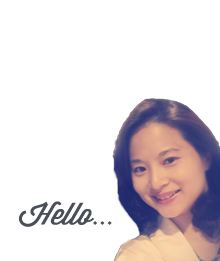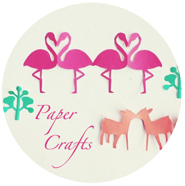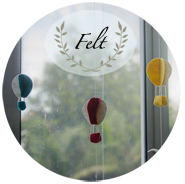K was introduced to water-colour paints for our next open-ended art activity.
When he first dip his brush into the watercolor palette and applied the brush on the drawing paper, he frowned at what he saw, and told me that he did not like water-colours. As the paint colors could hardly be seen (we have been using tempera paints, and the color pigments on paper is a lot darker)
I had to spend some time explaining to him that watercolors are usually very light and transparent. Did a sample creation of my own artwork with watercolors to demonstrate that watercolors have a very different outcome on paper, compared to the tempera and poster color paints that he was used to.
After he was convinced that watercolors were different and not so bad after all, he went on to paint an ‘abstract’ creation of gradation shades of green and orange. Then he ran into his room and came back to the hall with a pack of markers, and started adding on to his artwork.

Again, all I saw was stick people, differentiated in groups of different colors, with speech bubbles coming out of their heads and lots of numbers. Sure looks like his usual style of drawing, I thought. But boy, was I blown away when I asked him what was this artwork all about.
He told me to write all that he will dictate to me. As this dictation will be a write-up for his ‘Masterpiece’ (in his own words), next to his drawing. Very much like how art museums always have a short explanation of the artwork displayed next the artwork itself.
“It is in Japan because of the flag, the Japanese people (referring to the stick people in blue) are looking at the art piece in the museum. And the tourists too, the American guy cut his leg when he was kicking the sign (the stick people drawn with a pencil). The Turkey people (the ones in red) just love the art, they are saying, “Is this a good artist? But if you don’t see and don’t make this, you are a bad artist.” The ones in orange are from Malaysia, they just love cupcakes and they think that this is a extinct cupcake.
But actually the sign says that it is extinct guns and weapons and extinct volcanoes too, and some extinct dead people. The art is made in 1963. The purple numbers means that the people can be any age to look at the art piece. 5 and 6 years olds can also look at it. There is a TV on top so that the 5, 6 year olds can watch the TV and be distracted away from the violent art piece.
The statue has extinct buildings and houses and dinosaurs too. The house is 700,000 years old and they are extinct and crushed. The blocks inside the art piece (I think he meant apartment blocks) has the numbers 65 and 75. There are extinct animals and people. When the people are 100 years old, they die, but the animals only die when they are 200 years old.
Outside the museum there is a sign that says, the museum opens at 7 o’clock. And the outside of the door says ‘Open and Close at 7 o’clock’. The museum advertises robots fighting but the robots will explode in 1963.’
Then he loudly exclaimed, “That’s it. This is my masterpiece and I am an artist today – not an author and illustrator, so you have to write for me.”
I was quite amused by what he said. The word ‘tourist’ was explained to him two days ago when we spent an afternoon at Sentosa. Hearing the story that he created behind this art piece gave a good glimpse into the things that he tends to spend a lot more time thinking about. While others were learnt through new picture books that we read the last 1 month. From dinosaurs, weapons, volcanoes, dead people, people from different countries, violence in art, signs, time and year, and advertising.

What I learnt from this experience :
– There were facts addressed in his story that did not correlate with the facts that he learnt; i.e, about buildings and people being extinct, but I made a point not to correct him. This activity was meant to encourage higher level of abstract thinking through his creations (thinking out-of-the-box) and not correctly answer factual information.
– This demonstrated how art can help with a child’s self-expression, create opportunities for problem solving and creative stories behind the art work. There have been research studies done to prove that art therapy works in children to bring out suppressed emotions to the surface, where parents/teacher can help address them.
– It proves that parents should never under-estimate the simplicity of symbolism used in open-ended art. Free-expression can be encouraged in open-ended art, and children can be given the freedom to add any symbols that they want in their creations; words, numbers or anything abstract. Most importantly, ask open-ended questions after the child have finished the artwork and encourage the dictation of the stories behind their creations.
– Visiting art museums can be beneficial for children. Children exhibits may be beneficial as it gives children the avenue to play and interact with the displays that are set up, but I think what is more beneficial is for the child to experience the regular art exhibits in the museum.
 from Roubs Production Flick
from Roubs Production Flick
Visiting the art museum is a wonderful way to encourage your child’s appreciation and understanding of the arts. But do let them enjoy the art themselves. By all means, read the description of the art piece, the interpretation of the work by the artist. But let them enjoy the art, taking in the colors, the emotions behind each creation and the artist’s inspiration. Don’t feel pressured that you will need to interpret everything for them and have to ask them plenty of questions on each piece.
After experiencing such interesting outcomes and watching the process from our home-learning art lessons, I am so motivated to pursue more art experiences moving forward. K is not the only one who is learning from his art experiences, I am learning just as much from these art experiences too!
Do give this method a try with your next open-ended art experience with your child, and I am sure your child will delight you with their little interesting stories behind their art creations.
An edited version of this article was published on myplayschool.net
And here is how I incorporated open ended outcomes to a structured art experience.

 So lately when the teacher feedback that K does not stop talking during class, I am very sure that it is an indication that coloring is boring him tremendously in class! He is showing resistance lately when it comes to completing his homework from school. He finishes the written sections but when it comes to coloring, he tells me that he gets very tired of coloring.
So lately when the teacher feedback that K does not stop talking during class, I am very sure that it is an indication that coloring is boring him tremendously in class! He is showing resistance lately when it comes to completing his homework from school. He finishes the written sections but when it comes to coloring, he tells me that he gets very tired of coloring.

 Squares with Concentric Circles by Wassily Kandinsky, 1913
Squares with Concentric Circles by Wassily Kandinsky, 1913






















